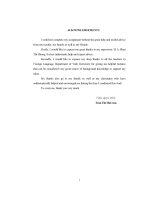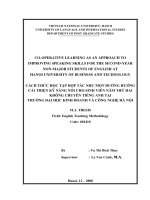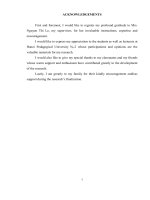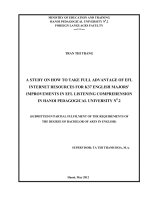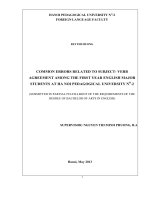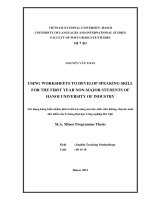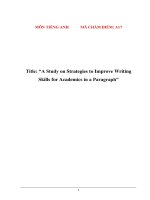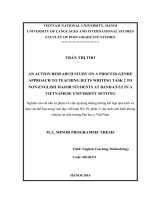A study on how to enrich english vocabulary for the first year english major students at ha noi pedagogical university no 2
Bạn đang xem bản rút gọn của tài liệu. Xem và tải ngay bản đầy đủ của tài liệu tại đây (431.57 KB, 48 trang )
ACKNOWLEDGEMENTS
First and foremost, I would like to register my profound gratitude to Mrs.
Nguyen Thi Le, my supervisor, for her invaluable instructions, expertise and
encouragement.
I would like to express my appreciation to the students as well as lecturers at
Hanoi Pedagogical University N0.2 whose participations and opinions are the
valuable materials for my research.
I would also like to give my special thanks to my classmates and my friends
whose warm support and enthusiasm have contributed greatly to the development
of the research.
Lastly, I am greatly to my family for their kindly encouragement endless
support during the research’s finalization.
i
ABSTRACT
Vocabulary learning strategies play an important role in vocabulary learning.
Admittedly, lack of vocabulary knowledge will have an effect on all four of
language skills: listening, reading, writing, and speaking. In addition, vocabulary
learning and word retention are always the problems encountered by students at
university. This study, hence, investigates EFL students studying English as a
second language in Hanoi Pedagogical University N0.2.
This study explores the strategy use of vocabulary learning among EFL
learners. The study could not have been completed without the help of FLF
students at HPU2. A sample of 100 respondents participated in the study. Data
collection was carried out through questionnaires. The results revealed awareness
of students about how importance of vocabulary learning is in learning English,
their beliefs in learning English vocabulary and their strategies most used in
learning new words.
Based on the results of the survey, some effective strategies for students in
learning new words are presented to help them as well as those who have interest
in the field of learning English vocabulary.
ii
STATEMENT OF AUTHORSHIP
Title: A study on how to enrich English vocabulary for the first-year
English major students at Hanoi Pedagogical University N0.2
(Graduation paper submitted in partial fulfillment of
the Degree of Bachelor of Arts in English)
I certify that no part of this study has been copied or reproduced by me from
any other person’s work without acknowledgements and that the study is originally
written by me under strict guidance from my supervisor.
Date submitted: May 2013
Student
Supervisor
Luu Thi Hong Men
Nguyen Thi Le, M.A.
iii
LIST OF ABBREVIATION
EFL
: English as a Foreign Language
FLF
: Foreign Language Faculty
HPU2
: Hanoi Pedagogical University N0.2
L1
: Native language
L2
: Second language
LLS
: Language learning strategies
VLS
: Vocabulary learning strategies
iv
LIST OF TABLES
Table 1: A taxonomy of Schmitt’s vocabulary learning strategies
Table 2: Personal information of the study participants
Table 3: The importance of vocabulary learning
Table 4: Attitudes of students toward learning of English vocabulary
Table 5: The most-used strategies reported by students
Table 6: The frequency of vocabulary learning strategies students do
v
TABLE OF CONTENTS
Acknowledgements .......................................................................................... i
Abstract ............................................................................................................ ii
Statement of authorship ................................................................................... iii
List of abbreviation .......................................................................................... iv
List of tables ..................................................................................................... v
Table of contents .............................................................................................. vi
PART ONE
INTRODUCTION
I.
Rationale ............................................................................................ 1
II.
Aim of the study ................................................................................ 2
III.
Scope of the study .............................................................................. 2
IV.
Methods of the study ......................................................................... 2
V.
Significance of the study ................................................................... 3
VI.
Design of the study ............................................................................ 3
PART TWO
DEVELOPMENT
CHAPTER ONE: THEORETICAL BACKGROUND
I.1: Literature review in brief .......................................................................... 4
I.2. Language learning strategies (LLS).............................................................. 5
I.2.1.The definitions of learning strategy ................................................. 5
I.2.2.The characteristics of learning strategy ............................................ 5
I.3. Vocabulary and vocabulary learning strategies ............................................ 6
I.3.1. Knowing a word ............................................................................... 6
I.3.2. Vocabulary learning strategies (VLS)............................................... 7
I.3.2.1. The definitions of vocabulary learning strategies.................... 7
I.3.2.2. Classifications of vocabulary learning strategies..................... 8
I.3.2.2.1. O’ Malley & Chamot’s VLS classification ........................ 8
I.3.2.2.2. Gu and Johnson’s VLS classification ................................. 8
I.3.2.2.3. Nation’s VLS classification ............................................... 8
vi
I.3.2.2.4. Oxford’s VLS classification .............................................. 9
I.3.2.3. Clarifying Schmitt’s vocabulary learning strategies ................ 10
CHAPTER TWO: METHODOLOGY
II.1. Participants ................................................................................................. 14
II.2. Research instrument.................................................................................... 14
II.3. Data collection ............................................................................................ 15
II.4. Method of data analysis .............................................................................. 15
II.5. Data analysis............................................................................................... 15
II.5.1. Students’ background information ................................................. 15
II.5.2. Students’ attitudes of learning vocabulary ..................................... 16
II.5.3. Students’ ways of learning vocabulary........................................... 18
CHAPTER THREE: MAJOR FINDINGS, DISCUSSION AND
RECOMMENDATION OF SEVERAL EFFECTIVE STRATEGIES FOR
ENRICHING ENGLISH VOCABULARY
III.1: Major findings and discussion ................................................................... 25
III.2: Recommendation of several effective strategies to enrich English
vocabulary for the first-year English major students at Hanoi Pedagogical
University N0. 2 .................................................................................................. 26
III.2.1: Reading English materials as much as you can ............................. 26
III.2.2: Using a dictionary ........................................................................ 27
III.2.3: Learning roots, prefixes, suffixes.................................................. 28
III.2.4: Create your own theme groups ..................................................... 29
III.2.5: Making your own word list........................................................... 31
III.2.6: Using a thesaurus ......................................................................... 31
III.2.7: Listening to the radio and watch film and television programs that
use a college-level vocabulary.................................................................. 32
III.2.8: Using some vocabulary websites .................................................. 32
vii
PART THREE
CONCLUSION
CONCLUSION................................................................................................. 34
REFERENCES ................................................................................................. 35
APPENDIX ....................................................................................................... 37
SURVEY QUESTIONNAIRES ....................................................................... 37
viii
PART ONE
INTRODUCTION
I. Rationale
Vocabulary is central to language and is of great significance to language
learners. Words are the building blocks of a language since they label objects,
actions, ideas without which people cannot convey the intended meaning. The
prominent role of vocabulary knowledge in second or foreign language learning
has been recently recognized by theorists and researchers in the field. Wilkins
(1976, cited in Thornbury 2002, p.13) contends that “without grammar very little
can be conveyed, without vocabulary nothing can be conveyed”, hence the crucial
role of vocabulary in language learning.
English language is very important and in learning English language
students have to learn vocabulary. Vocabulary is a vital aspect in language,
because it is essential for enhancing the four basic language skills, namely
listening, speaking, reading and writing. It is of utmost importance to people’s
communication and language learning.
Learning vocabulary is a very important part of learning a language. The
more words you know, the more you will be able to understand what you hear and
read; and the better you will be able to communicate (speak and write) clearly and
concisely. In fact, many first-year English major students realize that their
vocabulary is limited so that they have difficulties in expressing their idea. Another
problem student faces in learning English vocabulary is that they learn new words,
but they tend to forget what they have learned quite soon after they just learned
them. Moreover, students often complain they don’t know how to memorize
massive vocabulary and thus, in turn, lose interest in English learning. However,
increasing English vocabulary is a challenging task because it depends on many
factors such as the teachers, students, learning strategies and so on. This task still
needs more attention and research.
1
From my own interest in the field of vocabulary and the need to exploit
efficient learning strategies that students can use to increase their vocabulary, I
have conducted the study with the title: “A study on how to enrich English
vocabulary for the first-year English major students at Hanoi Pedagogical
University N0.2.”
II. Aim of the Study
The ultimate goal of the study is to help the first-year English major students
to establish and enrich their English vocabulary learning. The study aims
specifically to:
1) Explore students’ attitudes of English vocabulary learning.
2) Explore strategies are used the most by the EFL students in English
vocabulary learning.
3) Suggest some effective strategies to improve students’ vocabulary learning.
III. Scope of the Study
The general research area of this study is vocabulary.
The phenomenon is strategies for learning vocabulary made by the first-year
students of English of Foreign Language Faculty at HPU2 in the academic year of
2012/2013. Others relating to vocabulary are also briefly mentioned.
The population involved in the study is one hundred the first-year English
major students at HPU2.
IV. Methods of the Study
The study was carried out based on material collection and survey
questionnaires.
For the theoretical basis, referential materials on English vocabulary and
strategies for enriching vocabulary were gathered, synthesized and analyzed. The
problems were also pointed out, implications and suggestions were included.
For the practical basis, all the information and experience gathered from
survey questionnaires with the first-year English major students were used to find
out the effective strategies for enriching English vocabulary.
2
V. Significance of the Study
The study was carried out to give a clear picture about vocabulary learning
of the first-year English major students at HPU2. It also highlights the important
role of enriching English vocabulary. More importantly, it offers the theoretical
basis for the implication of vocabulary strategies. Pedagogically, the findings of
the study are believed to be useful for the first-year English major students to seek
ways to increase their vocabulary. Thus, it can help student create a relaxing and
effective vocabulary learning atmosphere where students are willing to learn for
their own interest. In addition, the study is also beneficial to anyone who is
interested in English, specially in enlarging vocabulary.
VI. Design of the Study
The study has three main parts, namely: the introduction, the development
and the conclusion.
Part one: The introduction presents the rationale, the aims, scope, research
methods and the design of the study.
Part two: The development consists of three chapters.
Chapter one: The literature review presents in brief theoretical background
including vocabulary and strategy for learning vocabulary.
Chapter two: Methodology. This chapter presents the method used in the
study including participants, research instrument, data collection, method of data
analysis, and data analysis.
Chapter three: This chapter shows the detailed results and analysis on the
data collected from the survey questionnaires.
Part three: The conclusion provides a review of the study.
3
PART TWO
DEVELOPMENT
CHAPTER ONE
THEORETICAL BACKGROUND
I.1. LITERATURE REVIEW IN BRIEF
Vocabulary is a vital aspect in any language because it appears in every skill
of language: listening, speaking, reading, and writing skill. Vocabulary learning
strategies are a part of language learning strategies which in turn are a part of
general learning strategies. It’s very useful to help student to learn English
vocabulary quickly and easily. It is the reason why many researchers have put
much effort in studying vocabulary learning strategies like Oxford (1990), Gu and
Johnson (1996), Nation (2001), Višnia Pavičić Takač (2008). They each have their
own way to describe the vocabulary learning strategies. Generally, they focus their
attention on the definition, classification, characteristics and uses of the vocabulary
learning strategies.
In the book Learning Vocabulary in Another Language, Nation (2001) refers
to the definition and the role of vocabulary learning strategies in guessing from
context. Moreover, he pays much attention to some word study strategies such as
word parts strategies, using dictionaries, learning from word cards.
Oxford (1990) gives a very comprehensive taxonomy or classifications of
language learning strategies. The key distinction in this taxonomy is that between
direct strategies and indirect strategies. Oxford divides the direct strategies into
three: memory strategies, cognitive strategies, and compensation strategies. On the
other hand, indirect strategies cover metacognitive strategies, affective strategies
and social strategies.
Višnia Pavičić Takač (2008) in the book Vocabulary Learning Strategies
and Foreign Language Acquisition only focuses his attention on survey of
research, research methods and studies on vocabulary learning strategies.
4
In the book Vocabulary Learning Strategies and Language Learning
Outcomes, Gu and Johnson (1996) mention to the definition of vocabulary learning
strategies. They establish two main dimensions of vocabulary learning strategies
for their study: metacognitive regulation and cognitive strategies which cover six
subcategories namely, guessing, using a dictionary, note-taking, rehearsal,
encoding, and activating strategies.
In short, much research on vocabulary learning strategies has been carried
out but has not made the point. Therefore, it is essential to have quite a clear
picture of effective strategies to enrich students’ vocabulary.
I.2. Language learning strategies (LLS)
I.2.1. The definitions of language learning strategies
Many definitions of LLS are defined differently by researchers. According
to Wenden & Rubin (1987, p.23), LLS is considered as the ones “which contribute
to the development of the language system which the learner constructs and affect
learning directly”. O’Malley & Chamot (1990, p.1) regard LLS as “the special
thoughts or behaviors that individuals use to help them comprehend, learn, or
retain new information”. Another interpretation comes from Oxford (2001, p.166),
who defines LLS as “operations employed by the learner to aid the acquisition,
storage, retrieval and use of information, specific actions taken by the learner to
make learning easier, faster, more enjoyable, more self-directed, more effective
and more transferable to new situations”. According to Cohen (as cited in Ellis
1999, p. 531), “learning strategies are learning processes which are consciously
selected by the learner. The words ‘consciously selected’ are important because
they demonstrate the special character of strategy”.
I.2.2. The characteristics of language learning strategies
Oxford (1990, p.9) also proposes a list of twelve key features involving
LLS, claiming that they:
1. contribute to the main goal, communicative competence.
2. allow learners to become more self-directed.
3. expand the role of teachers.
5
4. are problem-oriented.
5. are specific actions taken by the learner.
6. involve many aspects of the learner, not just the cognitive.
7. support learning both directly and indirectly.
8. are not always observable.
9. are often conscious.
10. can be taught.
11. are flexible.
12. are influenced by a variety of factors.
Among the features above, the tenth argument indicates that strategies are
able to be instructed to language learners. It plays an important role supporting
language practitioners to study this issue further so that students can boost their
learning by receiving appropriate strategy instructions.
I.3. Vocabulary and vocabulary learning strategies
I.3.1. Knowing a word
Knowing and learning a word means knowing a word receptively and
productively. Being able to understand a word while listening to a text is known as
receptive knowledge on the other hand, being able to use a word in spoken and
written form is understood as productive knowledge.
It is widely believed that people learn words receptively first and later
achieve productive knowledge (Schmitt 2000). He further proposes the following
list of the different kinds of knowledge that a person must master in order to know
a word:
- The meaning of the word
- The written form of a word
- The spoken form of the word
- The grammatical behavior of the word
- The collocations of the word
- The register of the word
- The associations of the word
6
- The frequency of the word
Nation (2001) suggests other aspects that are involved in knowing a word
completely: form-spoken, written and word parts, meaning-from and meaning,
concepts and references, associations, use-grammatical function, collocations and
constraints on use.
Based on above aspects of knowing a word, we can say that a word is a
complex item and the learner needs more than one exposure to learn and remember
it. The different forms of word knowledge need to be learned gradually over a long
period of time. Each exposure to a word is a chance to accumulate the different
types of lexical knowledge.
There is no doubt that attention to form and meaning of the unknown lead to
a word retention. In some case this may involve memorization of units that will
later be analyzed and in other cases may involve learning a rule or pattern that is
subsequently practiced and used.
I.3.2. Vocabulary learning strategies
I.3.2.1. The definitions of vocabulary learning strategies
Researchers define vocabulary learning strategies just according to the
definition of learning strategies. Nation (2001, p.217) states that “vocabulary
learning strategies are a part of language learning strategies which in turn are a part
of general learning strategies”. Based on O’Malley and Chamot’s (1990) definition
of learning strategies, Schmitt (1997) defined that learning is “the process by
which information is obtained, stored, retrieved and used. Therefore, vocabulary
learning strategies could be any which affect this broadly defined process” (p.
203). Nation (2001), instead of providing a clear-cut definition of vocabulary
learning strategies, has opted for listing their characteristics. According to one
researcher, “a strategy must involve choice (i.e. there should be several strategies
to choose from), be complex (i.e. there should be several steps to learn), require
knowledge and benefit from training, and increase the efficiency of vocabulary
learning and vocabulary use” (Nation, 2001, p. 217).
7
I.3.2.2. Classifications of vocabulary learning strategies
There are numerous different classification systems for vocabulary learning
strategies. Some representative classifications are listed at the following.
I.3.2.2.1. O’Malley and Chamot’s VLS classification
O'Malley and Chamot (1990) identified three categories of vocabulary
learning strategies, cognitive, metacognitive and social/affective. Cognitive
strategies are specified as learning steps that learners take to transform new
material, for inference, contextual guessing and relating new information to other
concepts from memory. Metacognitive strategies involve consciously directing
one’s own efforts into the learning task. Social/affective strategies involve
interaction with another person or taking control of one’s own feelings on language
learning.
I.3.2.2.2. Gu and Johnson’s VLS classification
Gu and Johnson (1996) conducted a questionnaire to investigate Chinese
advanced learners’ use of English vocabulary learning strategies, they divided
vocabulary learning strategies into two classes: cognitive and metacognitive
strategies. Cognitive strategies contain memory strategies, classification strategies,
guessing strategies, dictionary strategies, note-taking strategies and activation
strategies. Metacognitive strategies contain plan-making strategies, self-evaluating
strategies, self-checking strategies and selectively distributing attention strategies.
I.3.2.2.3. Nation’s VLS classification
Nation (2001) divided vocabulary learning strategies into three general
classes: planning, sources and process.
* Planning (Choosing what to focus on and when to focus on it): includes
choosing words, choosing the aspects of word knowledge, choosing strategies, and
planning repetition.
* Sources (Finding information about words): involves analyzing the words,
using word part, learning from word cards, using context, using a dictionary,
consulting a reference source in native language (L1) and second language (L2),
and using parallels in L1 and L2.
8
* Process (Establishing knowledge): includes noticing, retrieving, and
generating.
I.3.2.2.4. Oxford’s VLS classification
Oxford’ taxonomy is one of the most accepted and comprehensive
classification. Oxford (1990) classified vocabulary learning strategies into two
main types: direct strategies and indirect strategies. Direct strategies are the
strategies that directly involve the target language in the sense that they need
mental processing of the language. Indirect strategies indirectly support language
learning by arranging, evaluating, lowering anxiety, encouraging oneself,
cooperating
with others, asking questions, and other ways. Direct strategies
include memory, cognitive and compensation strategies. Memory strategies are
those that help students to store and retrieve information. Cognitive strategies
enable learners to understand and produce new language. Compensation strategies
allow learners to overcome knowledge gaps to communicate. Indirect strategies
include
three
strategies:
metacognitive,
affective
and
social
strategies.
Metacognitive strategies allow learners to control their own learning through
organizing, planning, and evaluating. Affective strategies help learners gain control
over their emotions, attitudes, motivations, and values. Social strategies help
learners interact with other people. The detailed Oxford’s (1990) taxonomy of
language learning strategies is as follows:
* Direct strategies
1. Memory strategies
A. Creating mental linkages
B. Applying images and sounds
C. Reviewing well
D. Implying action
2. Cognitive strategies
A. Practicing
B. Receiving and sending messages
C. Analyzing and reasoning
9
D. Creating structure for input and output
3. Compensation strategies
A. Guessing intelligently
B. Overcoming limitations in speaking and writing
* Indirect strategies
1. Metacognitive strategies
A. Centering your learning
B. Arranging and planning your learning
C. Evaluating your learning
2. Affective strategies
A. Lowering your anxiety
B. Encouraging yourself
C. Taking your emotional temperature
3. Social strategies
A. Asking questions
B. Cooperating with others
C. Empathizing with others
I.3.2.3. Clarifying Schmitt’s vocabulary learning strategies
A complete inventory of VLS will be conducive to pertinent studies in this
area. Schmitt (1997) attempted to propose a comprehensive taxonomy of VLS as
possible and classified them based on Oxford’s classification system. He primarily
referred to Oxford’s (1990) classification scheme and adopted four strategy groups
(social, memory, cognitive, and metacognitive) which seemed best able to illustrate
the wide variety of VLS. Social strategies involve learners using interaction with
other people to facilitate their learning. Memory strategies consist of those
approaches helping relate new materials to existing knowledge system. Skills
which require “manipulation or transformation of the target language by the
learner” (Oxford 1990, p.43) fall into the cognitive strategies. Lastly, according to
Schmitt, metacognitive strategies “involve a conscious overview of the learning
10
process and making decisions about planning, monitoring, or evaluating the best
way to study” (1997, p.205).
Since Oxford’s system deals with LLS in general and thus seems not to be
able to cover certain specific strategies used in vocabulary learning, Schmitt
created a new category for those strategies learners employ when discovering a
new word’s meaning without consulting other people, namely determination
strategies. In addition, a helpful distinction suggested by Cook and Mayer (1983)
and Nation (1990) was incorporated into Schmitt’s classification scheme. That is,
in terms of the process involved in vocabulary learning, strategies may be divided
into two groups: (a) those for the discovery of a new word’s meaning (discovery
strategies) and (b) those for consolidating a word once it has been encountered
(consolidation strategies). Table 1 better illustrates the complete classification
scheme proposed by Schmitt.
Table 1. A taxonomy of Schmitt’s vocabulary learning strategies
Determination strategies
Vocabulary
Discovery strategies
Social strategies
Learning
Social strategies
Strategies
Memory strategies
(VLS)
Consolidation strategies
Cognitive strategies
Metacognitive strategies
Strategies are used for the discovery of a new word’s meaning
Determination strategies (DET): The strategies are used to discover a new word’s
meaning without recourse to another’s expertise when learners don’t know a word.
For instance, learners can use a dictionary, analyze any available pictures or
gestures or guess meaning from textual context.
Social strategies (SOC): The strategies are employed to ask someone who knows.
Learners can ask teacher or classmates about information in a variety of ways, such
as a synonym, paraphrase, or L1 translation of new word.
11
Strategies are used for consolidating a word once it has been encountered
Social strategies (SOC): They can also be employed to consolidate learned words
by interacting with other people like studying and practicing meaning in a group.
Memory strategies (MEM): The strategies (traditionally known as mnemonics)
involve connecting the word to be retained with some previously learned
knowledge, using some form of imagery, or grouping. A new word can be
integrated into many kinds of existing knowledge (i.e. previous experiences or
known words) or images can be custom-made for retrieval (i.e. images of the
word’s form or meaning attributes).
(1) Picture/imagery: Learners study new words with pictures of their meaning
instead of definition.
(2) Related words: New words can linked to L2 words that the student already
knows. Usually this involves some type of sense relationship, such as
coordination (blue – other kinds of color like red, purple or white), synonymy
(beautiful-pretty), or antonym (dead-alive).
(3) Unrelated words: Learners can also link words together that have no sense
relationships. One way of doing this is with “peg” or “hook” words. One first
memorizes a rhyme like “one is a bun, two is a shoe, three is a tree etc.” Then
an image is created of the word to be remembered is chair, then an image is
made of a bun (peg word) resting on a chair. Recitation of the rhyme draws up
these images, which in turn prompt the target words.
(4) Grouping: It is an important way to aid recall, and people seem to organize
words into groups naturally without prompting.
(5) Word’s orthographical or phonological form: It involves focusing on the target
word’s orthographical or phonological form to facilitate recall. One can
explicitly study the spelling or pronunciation of a word. Other options are to
visualize the orthographical form of a word in an attempt to remember it, or to
make a mental representation of the sound of a word, perhaps making use of
rhyming words. The Keyword Method entails a learner finding a L1 word
which sounds like the target L2 word, i.e. the English word cat for the Japanese
12
word katana (sword). Then an image combing the two concepts is created, such
as a samurai cat waving a sword. When the L2 word is later heard, the sound
similarity invokes the created image which prompts the L2 word’s meaning.
(6) Other memory strategies: There are other useful ways of consolidating its
meaning, such as analyzing a word’s affixes, root, and word class. One way of
increasing one’s vocabulary is to analyze and learn the individual words of
these chunks, and then use the whole chunk (if it is transparent enough) as a
mnemonic device for remembering the individual word meanings. In addition,
the use of physical action can also facilitate language recall.
Cognitive strategies (COG): The strategies are similar to memory strategies, but
are not focused so specifically on manipulative mental processing. They include
repetition and using mechanical means to study vocabulary. Another kind of
cognitive strategy is using study aids. Taking notes in class invites learners to
create their own personal structure for newly learned words, and also offers the
chance for additional exposure during review.
Metacognitive strategies (MET): Students used the strategies to control and
evaluate their learning, behaving an overview of the learning process in general.
13
CHAPTER TWO
METHODOLOGY
II.1. Participants
The participants in this study are the first-year students of English of Foreign
Language Faculty at HPU2 in the academic year of 2012/2013. The number of
participants is 100 students which are divided into two branches: Bachelor of
English (36 students) and Pedagogy of English (64 students). They are
approximately from 19 to 21 in age. The majority of students are female students.
They come from difficult provinces of the country and bring with them different
levels of English background. The total sample of students involved in the study is
100 and were chosen randomly.
The most difficulty of the learners is that they cannot express their ideas in
speaking and writing lessons and it is difficult for them to get the gist of
information from the conversation or texts in listening and reading lessons. They
said that the reason for these difficulties is that they lack a great deal of
vocabulary. So, there is a need to find ways to help the learners enrich their
vocabulary.
II.2. Research instruments
In order to achieve the purpose of present study, a questionnaire was both
quantitatively and qualitatively used to analyze the collected data in the study.
The survey questionnaires for the students were designed with two parts.
Part one was a six-item background questionnaire in order to get some
background information about students’ English learning experiences and attitudes
of learning vocabulary.
Part two was a vocabulary learning strategies questionnaire which was
modified based on the Oxford’s Strategies Inventory for Language Learning
(SILL) (1990). The instrument includes thirty-one vocabulary learning strategies,
and three more strategies should have been added by the participants. The purpose
of this questionnaire is to collect information about the strategies male and female
14
students use when they learn English vocabulary and generally most-used
strategies.
II.3. Data collection
The questionnaires were delivered to 100 students during the regular class
time in the classrooms. The students were given clear instruction before each item
so that they could respond appropriately to each item. The questionnaires were
expected to be returned within 30 minutes. After the questionnaires were returned,
the data were collected and the data were selected by analyzing the questionnaire
individually.
II.4. Method of data analysis
The data was analyzed using descriptive statistics to see the overall patterns
of vocabulary learning strategies used by the 100 first-year English major students
come from Course 38, Foreign Language Faculty at HPU2.
Data collected from students’ questionnaires were analyzed qualitatively to
describe what strategies were used in English vocabulary learning. The information
was then displayed in forms of tables.
II.5. Data analysis
This chapter presents the results of the research study. The first section, the
student background questionnaire reports what is the English learning background
of the participant and what they feel about learning vocabulary. The second
section, vocabulary learning strategies questionnaire reports the learning strategies
used by learners.
II.5.1. Students’ background information
In the first phase of the research, a six-item questionnaire was given to the
respondents. The background questionnaire collected data on a variety of
background categories. The participants have indicated their name, age, gender and
English language experience. It mainly served three purposes: to provide personal
data on participants, to get an overview of the English learning experience and to
elicit the opinions about learning vocabulary. The questionnaire was administered
in a written manner. Table 2 shows some personal information of students.
15
# of years
Gender
Age
studying
English
English
Enjoy learning
proficiency
English
Poor=52
Female
19-21
8-10
Good=45
Yes
Very good=0
Poor=3
Male
19
8-10
Good=0
Yes
Very good=0
Table 2: Personal information of the study participants
There were 3 male and 97 female learners included in the study. This shows
that there are more females studying foreign languages than males. The first data
collected from the survey questionnaires was years of learning English. The overall
number of years studying English was from 8-10 years of learning experience and
this is a good indicator that the study participants are good at learning English. It
can be inferred that these students had good background knowledge of English. In
fact, 0% of the participants had very good proficiency in English, 45% of the
participants were good in learning English and 55% had poor proficiency in
English. However, it was a very good point that all students enjoy learning English.
II.5.2. Students’ attitudes of learning vocabulary
It should be taken into account students’ attitudes toward learning of English
vocabulary. When they find it necessary to learn vocabulary for their study, they
would be highly motivated in learning process.
Regarding question number 4 related to the importance of learning
vocabulary from students’ point of view, it is worthy note that most of students,
namely 72% felt that vocabulary is very important in learning English and 28 % of
them considered it is important. This was expected because the adult learners know
that vocabulary development is a critical aspect of fluent communication.
16
28%
Very important
72%
Important
Table 3: The importance of vocabulary learning
The next question, question number 5 investigated about attitudes of
students toward learning of English vocabulary. Results of investigation were
shown in the following pie chart.
8%
14%
Very difficult
Difficult
Not difficult
78%
Table 4: Attitudes of students toward learning of English vocabulary
As can be seen from the table above, the majority of the students, namely
78% found English vocabulary learning difficult and 14% of
o them found it very
difficult. One of the reasons was that they must deal with a large number of new
words after each lesson. However, 8% of them thought that vocabulary learning
was not difficult.
17
